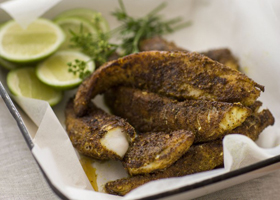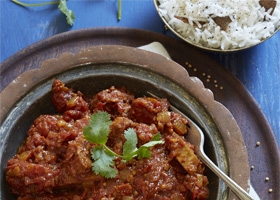Ingredients
- About 800g flathead fillets, skin off
- A little olive oil, for pan-frying
- Lemon or lime cheeks and herb sprigs, to garnish (optional)
Spice rub
- 2 teaspoons finely grated lime or lemon zest
- 1 tablespoon ground cumin
- 1 tablespoon ground coriander
- 1 tablespoon finely chopped fresh ginger
- 2 teaspoons mild chilli powder
- 1 – 1 ½ teaspoons freshly ground black pepper
- 1 teaspoon ground turmeric
- 1 teaspoon ground cinnamon
- 1 teaspoon salt
- 1 teaspoon caster sugar
- 1 teaspoon curry powder
Spice-coated flathead fillets

Flathead is such a lovely eating fish – sweet, white, moist, and not at all ‘fishy’. However don’t feel you have to use it for this recipe as many other fish would be fine too – snapper, bream, cobia – just don’t use anything too delicate as the peppery heat of the rub will overwhelm it. This is terrific served with mashed potatoes (and if they happen to be olive oil mashed potatoes, all the better!) and a simple green salad.
Method
Put all the ingredients for the spice rub into a bowl and thoroughly mix them together. Spread the rub out in a shallow dish that’s large enough to comfortably dunk the fillets, and set it aside.
Pat the fillets dry. If they’re really large, cut them in half so they’re easier to handle. Press one fillet at a time firmly into the spice rub and turn it so it’s well coated in the mixture – use your fingers to pat it on too. Give the fillet a gentle shake to dislodge any excess rub, then pop it onto a sheet of greaseproof paper (be careful not to overlap the fillets or the coating may become a bit soggy where they do). Repeat this with the remaining fillets.
Pour enough olive oil into a large frying pan to come about 4mm up the sides. Warm the oil over medium heat. Once it’s hot add as many fillets as will fit comfortably in the pan without crowding it. Cook them for 1 – 2 minutes each side, depending on their thickness, then transfer them to a plate lined with greaseproof paper.
Continue to cook the rest of the fillets in the same way. It’s nigh on impossible to give exact timing for cooking fish because every piece is just a little thicker or thinner than the next. The most important thing though is not to overcook the fish – because as it has little fat, there’s nothing to protect it from drying out.
To check if it’s ready, carefully insert the tip of a fine knife into one of the fillets, use it to separate the flesh a little and take a look – it should be moist, barely flaking and only just cooked through, as it will continue to cook from the residual heat once it’s out of the pan.
When they’re all done, either serve the fillets on individual plates or on a platter with a good pile of lemon or lime cheeks to squeeze over the top. Garnish with a few herb sprigs, if liked. Serves 4.
On curry powder-
I have a bit of a ‘thing’ for curried egg sandwiches so I always keep a tub of curry powder in the pantry as they just don’t taste at all right made with curry paste. I’ve tried a number of brands but can’t go past good old Clive of India – it is just so much nicer than most. I only mention this because I’ve been really disappointed in the flavour of some and it would be a shame to spoil the rub by using one that’s a bit dodgy.
Tips and Tricks
Fresh ginger lasts about a month in the fridge. Once it is chopped, try adding a little dry sherry and store it in a sealed jar in the fridge. It will last 2-3 months and once the ginger is gone, the sherry can be used to flavour other recipes.
If you haven’t got time to use up lemons in the kitchen, they also make for a great cleaning supplement in the rest of your house. Rubbing lemons onto aluminium will help brighten surfaces, while mixing 2 tablespoons of lemon with 1/2 cup vinegar and 1 litre of water makes for a natural window cleaner.
Substituting fresh herbs for dried herbs can be a great option if you don’t have any fresh to hand or you know you can’t use it all. A general rule is to use the 3:1 ratio—use 3 times more fresh than dried. eg. 1 tablespoon chopped fresh mint equals 1 teaspoon dried.






